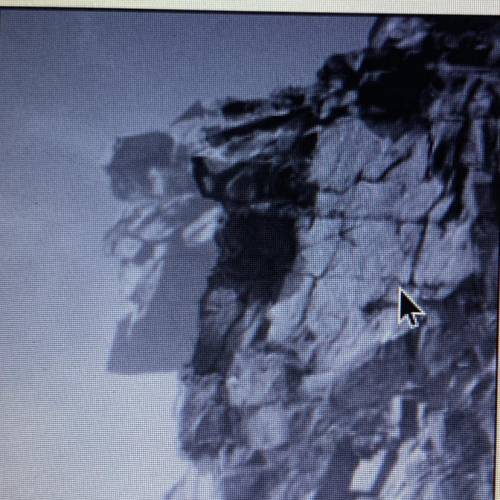
Biology, 11.03.2021 18:00, kayranicole1
HELP ASAP‼️‼️‼️The picture shows a landform that broke apart and the rock fell into the valley below. The rock was in high mountains, often subjected to harsh weather. The rock was made of solid
igneous rock, granite, with few plants growing on the cliff.
Based on the evidence, what most likely caused the rock to fall?
A. acid rain dissolving a fragile sedimentary rock.
B. freeze-thaw due to cold conditions forming cracks in the rock and spreading the cracks over time
C. tree roots growing between cracks in the rock and pushing the rock away from the cliff
D. oxidation with oxygen and water creating rust that slowly wore the rock away from the cliff


Answers: 3
Other questions on the subject: Biology

Biology, 22.06.2019 00:00, mya032
Mouse liver cells were homogenized and the homogenate subjected to equilibrium density-gradient centrifugation with sucrose gradients. fractions obtained from these gradients were assayed for marker molecules (i. e., molecules that are limited to specific organelles). the results of these assays are shown in the figure. the marker molecules have the following functions: cytochrome oxidase is an enzyme involved in the process by which atp is formed in the complete aerobic degradation of glucose or fatty acids; ribosomal rna forms part of the protein-synthesizing ribosomes; catalase catalyzes decomposition of hydrogen peroxide; acid phosphatase hydrolysis monophosphoric esters at acid ph; cytidylyltransferase is involved in phospholipid biosynthesis; and amino acid permease aids in transport of amino acids across membranes. a) name the marker molecule and give the number of the fraction that is most enriched for each of the following cell components: lysosomes; peroxisomes; mitochondria; plasma membrane; rough endoplasmic reticulum; smooth endoplasmic reticulum.
Answers: 3

Biology, 22.06.2019 06:50, naomi20044
What condition is kept close to its set point in osmoregulation? a. body temperature b. platelet count c. blood glucose level d. water balance
Answers: 1

Biology, 22.06.2019 07:30, dobrzenski8372
Which of the following situations describes a adaptation for a mole? question 2 options: a mole is blind and cannot see underground. a mole is bright and attracts the attention of predator birds. a mole has a sensitive sense of smell to it find food underground.
Answers: 1

Biology, 22.06.2019 08:10, donnafranks2003
Use the phylogenetic tree to the right to determine which statement below is true. organisms a and f are not related. organism e is more closely related to organism b than organism f. organisms c and d are more closely related than organisms a and b. phylogenetic trees
Answers: 2
Do you know the correct answer?
HELP ASAP‼️‼️‼️The picture shows a landform that broke apart and the rock fell into the valley below...
Questions in other subjects:

Mathematics, 05.11.2020 22:50

Mathematics, 05.11.2020 22:50

Mathematics, 05.11.2020 22:50


Computers and Technology, 05.11.2020 22:50

Health, 05.11.2020 22:50


Mathematics, 05.11.2020 22:50

Chemistry, 05.11.2020 22:50

English, 05.11.2020 22:50






